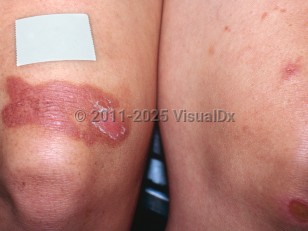Hogweed dermatitis in Adult
Alerts and Notices
Important News & Links
Synopsis

Giant hogweed (Heracleum mantegazzianum) is a plant that causes a phytophotodermatitis (a photosensitive dermal response) reaction. Exposure to the plant sap followed by sunlight causes a photosensitivity reaction. Hogweed is a tall plant with white flowers and a reddish-purple stem. In the United States, it grows predominantly on the East Coast and has also spread to Pennsylvania, Michigan, Indiana, Illinois, Wisconsin, Oregon, Washington, and Alaska. It is also found in Canada, Australia, Iran, Russia, and regions throughout Europe. It grows in sunny, moist areas by the river or roadside, along tree lines, and is a popular addition to many gardens. Attracted by its large size and hollow stem, children may be inclined to use it as a play telescope or sword. A toxic psoralen, furocoumarin, present in the sap is highly lipid soluble and penetrates into the epidermis. High humidity aids absorption of psoralens. Absorption of ultraviolet A (UVA) by the psoralens leads to nucleic acid damage and formation of free radicals. Subsequent cell death leads to the quick formation of painful blisters. Contact of the sap with the eyes can cause temporary or even permanent blindness.
Preceding the skin lesions, the patient may experience a burning sensation of the skin. This is followed by erythema, edema, and vesicle formation within 24 hours of contact with the hogweed sap. If severe, in addition to the skin lesions, patients experience headaches and generalized fatigue. They may also complain of feeling hot.
Because phytophotodermatitis is a phototoxic reaction in which there is no immunological response, prior sensitization is not required. This type of photodermatitis is usually followed by hyperpigmentation.
Symptoms usually develop within 24-48 hours following contact with the sap and sunlight exposure.
Patients may continue to have symptoms such as pain, fatigue, and photosensitivity for up to a month after the initial plant contact.
Activities that predispose to sap exposure include gardening, hiking, bike riding, or when children use the large, hollow stem for play purposes. Pets, especially dogs, commonly acquire sap on their fur, which is subsequently transferred to the pet owner. Also, farmers and fieldworkers may inadvertently be exposed to the plant.
Of note, exposure to the plant sap of wild parsnip (Pastinaca sativa; "poison parsnip") can also cause severe phytophotodermatitis. It is frequently found in road ditches and fields, and exposure has occurred while hiking or biking along trails and gardening (pulling weeds). When in bloom it looks similar to Queen Anne's lace or dill plant and grows to around 4 feet tall. It is common throughout the United States.
Preceding the skin lesions, the patient may experience a burning sensation of the skin. This is followed by erythema, edema, and vesicle formation within 24 hours of contact with the hogweed sap. If severe, in addition to the skin lesions, patients experience headaches and generalized fatigue. They may also complain of feeling hot.
Because phytophotodermatitis is a phototoxic reaction in which there is no immunological response, prior sensitization is not required. This type of photodermatitis is usually followed by hyperpigmentation.
Symptoms usually develop within 24-48 hours following contact with the sap and sunlight exposure.
Patients may continue to have symptoms such as pain, fatigue, and photosensitivity for up to a month after the initial plant contact.
Activities that predispose to sap exposure include gardening, hiking, bike riding, or when children use the large, hollow stem for play purposes. Pets, especially dogs, commonly acquire sap on their fur, which is subsequently transferred to the pet owner. Also, farmers and fieldworkers may inadvertently be exposed to the plant.
Of note, exposure to the plant sap of wild parsnip (Pastinaca sativa; "poison parsnip") can also cause severe phytophotodermatitis. It is frequently found in road ditches and fields, and exposure has occurred while hiking or biking along trails and gardening (pulling weeds). When in bloom it looks similar to Queen Anne's lace or dill plant and grows to around 4 feet tall. It is common throughout the United States.
Codes
ICD10CM:
L24.7 – Irritant contact dermatitis due to plants, except food
SNOMEDCT:
402579004 – Irritant contact dermatitis due to plant
L24.7 – Irritant contact dermatitis due to plants, except food
SNOMEDCT:
402579004 – Irritant contact dermatitis due to plant
Look For
Subscription Required
Diagnostic Pearls
Subscription Required
Differential Diagnosis & Pitfalls

To perform a comparison, select diagnoses from the classic differential
Subscription Required
Best Tests
Subscription Required
Management Pearls
Subscription Required
Therapy
Subscription Required
References
Subscription Required
Last Updated:11/11/2021
Hogweed dermatitis in Adult

